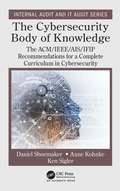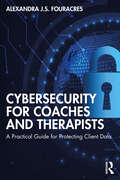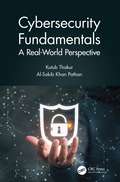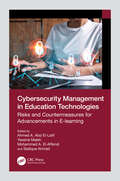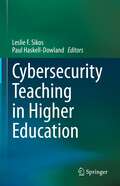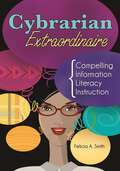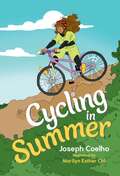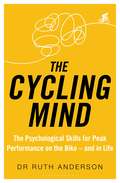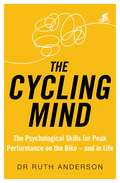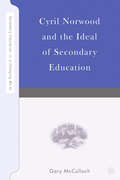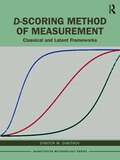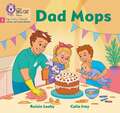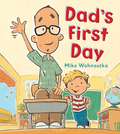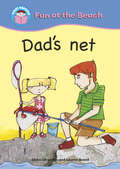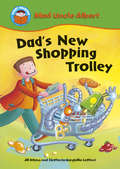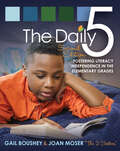- Table View
- List View
The Cybersecurity Body of Knowledge: The ACM/IEEE/AIS/IFIP Recommendations for a Complete Curriculum in Cybersecurity (Internal Audit and IT Audit)
by Daniel Shoemaker Anne Kohnke Ken SiglerThe Cybersecurity Body of Knowledge explains the content, purpose, and use of eight knowledge areas that define the boundaries of the discipline of cybersecurity. The discussion focuses on, and is driven by, the essential concepts of each knowledge area that collectively capture the cybersecurity body of knowledge to provide a complete picture of the field. This book is based on a brand-new and up to this point unique, global initiative, known as CSEC2017, which was created and endorsed by ACM, IEEE-CS, AIS SIGSEC, and IFIP WG 11.8. This has practical relevance to every educator in the discipline of cybersecurity. Because the specifics of this body of knowledge cannot be imparted in a single text, the authors provide the necessary comprehensive overview. In essence, this is the entry-level survey of the comprehensive field of cybersecurity. It will serve as the roadmap for individuals to later drill down into a specific area of interest. This presentation is also explicitly designed to aid faculty members, administrators, CISOs, policy makers, and stakeholders involved with cybersecurity workforce development initiatives. The book is oriented toward practical application of a computing-based foundation, crosscutting concepts, and essential knowledge and skills of the cybersecurity discipline to meet workforce demands. Dan Shoemaker, PhD, is full professor, senior research scientist, and program director at the University of Detroit Mercy’s Center for Cyber Security and Intelligence Studies. Dan is a former chair of the Cybersecurity & Information Systems Department and has authored numerous books and journal articles focused on cybersecurity. Anne Kohnke, PhD, is an associate professor of cybersecurity and the principle investigator of the Center for Academic Excellence in Cyber Defence at the University of Detroit Mercy. Anne’s research is focused in cybersecurity, risk management, threat modeling, and mitigating attack vectors. Ken Sigler, MS, is a faculty member of the Computer Information Systems (CIS) program at the Auburn Hills campus of Oakland Community College in Michigan. Ken’s research is in the areas of software management, software assurance, and cybersecurity.
The Cybersecurity Body of Knowledge: The ACM/IEEE/AIS/IFIP Recommendations for a Complete Curriculum in Cybersecurity (Internal Audit and IT Audit)
by Daniel Shoemaker Anne Kohnke Ken SiglerThe Cybersecurity Body of Knowledge explains the content, purpose, and use of eight knowledge areas that define the boundaries of the discipline of cybersecurity. The discussion focuses on, and is driven by, the essential concepts of each knowledge area that collectively capture the cybersecurity body of knowledge to provide a complete picture of the field. This book is based on a brand-new and up to this point unique, global initiative, known as CSEC2017, which was created and endorsed by ACM, IEEE-CS, AIS SIGSEC, and IFIP WG 11.8. This has practical relevance to every educator in the discipline of cybersecurity. Because the specifics of this body of knowledge cannot be imparted in a single text, the authors provide the necessary comprehensive overview. In essence, this is the entry-level survey of the comprehensive field of cybersecurity. It will serve as the roadmap for individuals to later drill down into a specific area of interest. This presentation is also explicitly designed to aid faculty members, administrators, CISOs, policy makers, and stakeholders involved with cybersecurity workforce development initiatives. The book is oriented toward practical application of a computing-based foundation, crosscutting concepts, and essential knowledge and skills of the cybersecurity discipline to meet workforce demands. Dan Shoemaker, PhD, is full professor, senior research scientist, and program director at the University of Detroit Mercy’s Center for Cyber Security and Intelligence Studies. Dan is a former chair of the Cybersecurity & Information Systems Department and has authored numerous books and journal articles focused on cybersecurity. Anne Kohnke, PhD, is an associate professor of cybersecurity and the principle investigator of the Center for Academic Excellence in Cyber Defence at the University of Detroit Mercy. Anne’s research is focused in cybersecurity, risk management, threat modeling, and mitigating attack vectors. Ken Sigler, MS, is a faculty member of the Computer Information Systems (CIS) program at the Auburn Hills campus of Oakland Community College in Michigan. Ken’s research is in the areas of software management, software assurance, and cybersecurity.
Cybersecurity for Coaches and Therapists: A Practical Guide for Protecting Client Data
by Alexandra J.S. FouracresThis groundbreaking book filters down the wealth of information on cybersecurity to the most relevant and highly applicable aspects for coaches, therapists, researchers and all other practitioners handling confidential client conversations and data. Whether working with clients online or face to face, practitioners today increasingly rely on the cyberspace as part of their practice. Through a solutions-focused lens, the book provides easy-to-apply practical advice and guidelines using non-technical language, enabling practitioners to mitigate the rising threat of cybercrime, which can no longer be ignored. By the last page the reader will have knowledge and awareness towards: securing devices, spotting financial fraud, mitigating the risks of online communications, operating more securely from a home office and handling a cyber event if one occurs. Clear, concise, and easy to follow, this guide is a pivotal resource for coaches, therapists, researchers and all other practitioners protecting their clients and businesses.
Cybersecurity for Coaches and Therapists: A Practical Guide for Protecting Client Data
by Alexandra J.S. FouracresThis groundbreaking book filters down the wealth of information on cybersecurity to the most relevant and highly applicable aspects for coaches, therapists, researchers and all other practitioners handling confidential client conversations and data. Whether working with clients online or face to face, practitioners today increasingly rely on the cyberspace as part of their practice. Through a solutions-focused lens, the book provides easy-to-apply practical advice and guidelines using non-technical language, enabling practitioners to mitigate the rising threat of cybercrime, which can no longer be ignored. By the last page the reader will have knowledge and awareness towards: securing devices, spotting financial fraud, mitigating the risks of online communications, operating more securely from a home office and handling a cyber event if one occurs. Clear, concise, and easy to follow, this guide is a pivotal resource for coaches, therapists, researchers and all other practitioners protecting their clients and businesses.
Cybersecurity Fundamentals: A Real-World Perspective
by Kutub Thakur Al-Sakib Khan PathanCybersecurity Fundamentals: A Real-World Perspective explains detailed concepts within computer networks and computer security in an easy-to-understand way, making it the perfect introduction to the topic. This book covers fundamental issues using practical examples and real-world applications to give readers a rounded understanding of the subject and how it is applied. The first three chapters provide a deeper perspective on computer networks, cybersecurity, and different types of cyberattacks that hackers choose to unleash on cyber environments. It then goes on to cover the types of major computer malware and cybersecurity attacks that shook the cyber world in the recent years, detailing the attacks and analyzing their impact on the global economy. The details of the malware codes that help the hacker initiate the hacking attacks on networks are fully described. It then covers high-tech cybersecurity programs, devices, and mechanisms that are extensively adopted in modern security systems. Examples of those systems include intrusion detection systems (IDS), intrusion prevention systems (IPS), and security firewalls. It demonstrates how modern technologies can be used to create and manage passwords for secure data. This book also covers aspects of wireless networks and their security mechanisms. The details of the most commonly used Wi-Fi routers are provided with step-by-step procedures to configure and secure them more efficiently. Test questions are included throughout the chapters to ensure comprehension of the material. Along with this book’s step-by-step approach, this will allow undergraduate students of cybersecurity, network security, and related disciplines to gain a quick grasp of the fundamental topics in the area. No prior knowledge is needed to get the full benefit of this book.
Cybersecurity Fundamentals: A Real-World Perspective
by Kutub Thakur Al-Sakib Khan PathanCybersecurity Fundamentals: A Real-World Perspective explains detailed concepts within computer networks and computer security in an easy-to-understand way, making it the perfect introduction to the topic. This book covers fundamental issues using practical examples and real-world applications to give readers a rounded understanding of the subject and how it is applied. The first three chapters provide a deeper perspective on computer networks, cybersecurity, and different types of cyberattacks that hackers choose to unleash on cyber environments. It then goes on to cover the types of major computer malware and cybersecurity attacks that shook the cyber world in the recent years, detailing the attacks and analyzing their impact on the global economy. The details of the malware codes that help the hacker initiate the hacking attacks on networks are fully described. It then covers high-tech cybersecurity programs, devices, and mechanisms that are extensively adopted in modern security systems. Examples of those systems include intrusion detection systems (IDS), intrusion prevention systems (IPS), and security firewalls. It demonstrates how modern technologies can be used to create and manage passwords for secure data. This book also covers aspects of wireless networks and their security mechanisms. The details of the most commonly used Wi-Fi routers are provided with step-by-step procedures to configure and secure them more efficiently. Test questions are included throughout the chapters to ensure comprehension of the material. Along with this book’s step-by-step approach, this will allow undergraduate students of cybersecurity, network security, and related disciplines to gain a quick grasp of the fundamental topics in the area. No prior knowledge is needed to get the full benefit of this book.
Cybersecurity Management in Education Technologies: Risks and Countermeasures for Advancements in E-learning
by Abd El-Latif, Ahmed A.This book explores the intersection of cybersecurity and education technologies, providing practical solutions, detection techniques, and mitigation strategies to ensure a secure and protected learning environment in the face of evolving cyber threats. With a wide range of contributors covering topics from immersive learning to phishing detection, this book is a valuable resource for professionals, researchers, educators, students, and policymakers interested in the future of cybersecurity in education. Features: • Offers both theoretical foundations and practical guidance for fostering a secure and protected environment for educational advancements in the digital age. • Addresses the need for cybersecurity in education in the context of worldwide changes in education sources and advancements in technology. • Highlights the significance of integrating cybersecurity into educational practices and protecting sensitive information to ensure students’ performance prediction systems are not misused. • Covers a wide range of topics including immersive learning, cybersecurity education, and malware detection, making it a valuable resource for professionals, researchers, educators, students, and policymakers.
Cybersecurity Management in Education Technologies: Risks and Countermeasures for Advancements in E-learning
This book explores the intersection of cybersecurity and education technologies, providing practical solutions, detection techniques, and mitigation strategies to ensure a secure and protected learning environment in the face of evolving cyber threats. With a wide range of contributors covering topics from immersive learning to phishing detection, this book is a valuable resource for professionals, researchers, educators, students, and policymakers interested in the future of cybersecurity in education. Features: • Offers both theoretical foundations and practical guidance for fostering a secure and protected environment for educational advancements in the digital age. • Addresses the need for cybersecurity in education in the context of worldwide changes in education sources and advancements in technology. • Highlights the significance of integrating cybersecurity into educational practices and protecting sensitive information to ensure students’ performance prediction systems are not misused. • Covers a wide range of topics including immersive learning, cybersecurity education, and malware detection, making it a valuable resource for professionals, researchers, educators, students, and policymakers.
Cybersecurity Teaching in Higher Education
by Leslie F. Sikos Paul Haskell-DowlandThis book collects state-of-the-art curriculum development considerations, training methods, techniques, and best practices, as well as cybersecurity lab requirements and aspects to take into account when setting up new labs, all based on hands-on experience in teaching cybersecurity in higher education.In parallel with the increasing number and impact of cyberattacks, there is a growing demand for cybersecurity courses in higher education. More and more educational institutions offer cybersecurity courses, which come with unique and constantly evolving challenges not known in other disciplines. For example, step-by-step guides may not work for some of the students if the configuration of a computing environment is not identical or similar enough to the one the workshop material is based on, which can be a huge problem for blended and online delivery modes. Using nested virtualization in a cloud infrastructure might not be authentic for all kinds of exercises, because some of its characteristics can be vastly different from an enterprise network environment that would be the most important to demonstrate to students. The availability of cybersecurity datasets for training and educational purposes can be limited, and the publicly available datasets might not suit a large share of training materials, because they are often excessively documented, but not only by authoritative websites, which render these inappropriate for assignments and can be misleading for online students following training workshops and looking for online resources about datasets such as the Boss of the SOC (BOTS) datasets. The constant changes of Kali Linux make it necessary to regularly update training materials, because commands might not run the same way they did a couple of months ago. The many challenges of cybersecurity education are further complicated by the continuous evolution of networking and cloud computing, hardware and software, which shapes student expectations: what is acceptable and respected today might be obsolete or even laughable tomorrow.
Cybrarian Extraordinaire: Compelling Information Literacy Instruction
by Felicia A. SmithEnhance your library instruction class by using this hands-on guide and learn numerous unique active learning exercises.The effectiveness of active-learning approaches to instruction is well documented. What is needed now are proven, practical applications. Written for every librarian or teacher looking for such new and creative teaching techniques, Cybrarian Extraordinaire: Compelling Information Literacy Instruction fills the gap. Based on the author's own experiences, the book shares specific active-learning exercises created to make library instruction more engaging for a wide variety of audiences.Specifically, author Felicia A. Smith illustrates the process of creating "edu-tainment" activities designed to serve serious instructional goals in a manner that is both fun and effective. Her book provides detailed examples of innovative ways to engage students in mandatory library classes. Among other ideas, it explores the use of e-readers as learning tools and describes the planning and possibilities involved in creating classes in online worlds, such as Second Life. Of course, it also explains the evolution of Smith's Pirate Librarian, offering exercises that reinforced the "library material as buried treasure" theme.
The Cycling Mind: The Psychological Skills for Peak Performance on the Bike - and in Life
by Ruth AndersonThis practical and highly accessible guide, written by a leading sport psychologist, will explore the importance of psychology in achieving peak cycling performance. The book will transfer the sport psychology strategies used in elite competition to equip individuals with the psychological skills to pursue performance excellence - on an off the bike. The Cycling Mind will take the reader through the key stages of an athlete's pathway, from training through to competition, and provide guidelines to developing the psychological skills to compete at their best. In addition the strategies explored in the book can be applied across all high-pressure performance environments, including business and daily life.Foreword by Joanna Rowsell Shand MBE, double Olympic gold medallist, winner of multiple world cycling championships and BBC commentator on major cycling competitions.
The Cycling Mind: The Psychological Skills for Peak Performance on the Bike - and in Life
by Ruth AndersonThis practical and highly accessible guide, written by a leading sport psychologist, will explore the importance of psychology in achieving peak cycling performance. The book will transfer the sport psychology strategies used in elite competition to equip individuals with the psychological skills to pursue performance excellence - on an off the bike. The Cycling Mind will take the reader through the key stages of an athlete's pathway, from training through to competition, and provide guidelines to developing the psychological skills to compete at their best. In addition the strategies explored in the book can be applied across all high-pressure performance environments, including business and daily life.Foreword by Joanna Rowsell Shand MBE, double Olympic gold medallist, winner of multiple world cycling championships and BBC commentator on major cycling competitions.
Cyril Norwood and the Ideal of Secondary Education (Secondary Education in a Changing World)
by G. McCullochTracing the life of Sir Cyril Norwood, one of England's most prominent and influential educators, this book investigates the historical development of secondary education in England and Wales during the early Twentieth century.
D-scoring Method of Measurement: Classical and Latent Frameworks (Quantitative Methodology Series)
by Dimiter DimitrovD-scoring Method of Measurement presents a unified framework of classical and latent measurement referred to as D-scoring method of measurement (DSM). Provided are detailed descriptions of DSM procedures and illustrative examples of how to apply the DSM in various scenarios of measurement. The DSM is designed to combine merits of the traditional CTT and IRT for the purpose of transparency, ease of interpretations, computational simplicity of test scoring and scaling, and practical efficiency, particularly in large-scale assessments. Through detailed descriptions of DSM procedures, this book shows how practical applications of such procedures are facilitated by the inclusion of operationalized guidance for their execution using the computer program DELTA for DSM-based scoring, equating, and item analysis of test data. In doing so, the book shows how DSM procedures can be readily translated into computer source codes for other popular software packages such as R. D-scoring Method of Measurement equips researchers and practitioners in the field of educational and psychological measurement with a comprehensive understanding of the DSM as a unified framework of classical and latent scoring, equating, and psychometric analysis.
D-scoring Method of Measurement: Classical and Latent Frameworks (Quantitative Methodology Series)
by Dimiter DimitrovD-scoring Method of Measurement presents a unified framework of classical and latent measurement referred to as D-scoring method of measurement (DSM). Provided are detailed descriptions of DSM procedures and illustrative examples of how to apply the DSM in various scenarios of measurement. The DSM is designed to combine merits of the traditional CTT and IRT for the purpose of transparency, ease of interpretations, computational simplicity of test scoring and scaling, and practical efficiency, particularly in large-scale assessments. Through detailed descriptions of DSM procedures, this book shows how practical applications of such procedures are facilitated by the inclusion of operationalized guidance for their execution using the computer program DELTA for DSM-based scoring, equating, and item analysis of test data. In doing so, the book shows how DSM procedures can be readily translated into computer source codes for other popular software packages such as R. D-scoring Method of Measurement equips researchers and practitioners in the field of educational and psychological measurement with a comprehensive understanding of the DSM as a unified framework of classical and latent scoring, equating, and psychometric analysis.
Dad Gets the Cat: Independent Reading Pink 1A (Reading Champion #1)
by Sue GravesReading Champion offers independent reading books for children to practise and reinforce their developing reading skills.Fantastic, original stories are accompanied by engaging artwork and a reading activity. Each book has been carefully graded so that it can be matched to a child's reading ability, encouraging reading for pleasure.Independent Reading Pink 1A stories are perfect for children aged 4+ who are reading at book band 1A (Pink) in classroom reading lessons.In this story, Dad has to keep rescuing the cat. Will she ever learn her lesson?
Dad Mops: Phase 2 Set 3 Blending Practice (big Cat Phonics For Little Wandle Letters And Sounds Revised)
by Roisin Leahy Celia Ivey Collins Big CatDad's First Day
by Mike WohnoutkaAll summer Oliver and his dad played together, laughed together, sang together, and read together.Now it's time for Oliver to start school!On the first day, Oliver's dad isn't quite ready. . . . Suddenly he feels nervous. His tummy hurts, and he would rather stay home.But Oliver isn't convinced. What if the first day is really fun? What if it's the start of an exciting year? In this charming story of first-day jitters, acclaimed author and illustrator Mike Wohnoutka perfectly captures the mixed emotions felt by kids and their parents when big changes are afoot.
Dad's First Day
by Mike WohnoutkaAll summer Oliver and his dad played together, laughed together, sang together, and read together.Now it's time for Oliver to start school!On the first day, Oliver's dad isn't quite ready. . . . Suddenly he feels nervous. His tummy hurts, and he would rather stay home.But Oliver isn't convinced. What if the first day is really fun? What if it's the start of an exciting year? In this charming story of first-day jitters, acclaimed author and illustrator Mike Wohnoutka perfectly captures the mixed emotions felt by kids and their parents when big changes are afoot.
Dad's Net: Fun At The Beach: Dad's Net (Start Reading: Pip's Pets #24)
by Claire LlewellynDad is fishing in a rock pool but he can't catch a fish!
Dad's New Clothes: Going Shopping (Start Reading: Going Shopping)
by Louise JohnMum and Poppy are taking Dad shopping but he does NOT like shopping! Dad's New Clothes is part of the Start Reading: Going Shopping series, four books at Red Band 2 of the Start Reading programme.
Dad's New Shopping Trolley: Mad Uncle Albert: Dad's New Shopping Trolley (library E (Start Reading: Mad Uncle Albert #8)
by Jill AtkinsMad Uncle Albert loves making machines and inventions for his family, but they don't always turn out as they should. Luckily Uncle Albert manages to save the day...
The Daily 5: Fostering Literacy Independence in the Elementary Grades
by Gail Boushey Joan MoserThe Daily 5: Fostering Literacy in the Elementary Grades, Second Edition retains the core literacy components that made the first edition one of the most widely read books in education and enhances these practices based on years of further experience in classrooms and compelling new brain research. The Daily 5 provides a way for any teacher to structure literacy (and now math) time to increase student independence and allow for individualized attention in small groups and one-on-one. Teachers and schools implementing the Daily 5 will do the following: Spend less time on classroom management and more time teaching Help students develop independence, stamina, and accountability Provide students with abundant time for practicing reading, writing, and math Increase the time teachers spend with students one-on-one and in small groups Improve schoolwide achievement and success in literacy and math. The Daily 5, Second Edition gives teachers everything they need to launch and sustain the Daily 5, including materials and setup, model behaviors, detailed lesson plans, specific tips for implementing each component, and solutions to common challenges. By following this simple and proven structure, teachers can move from a harried classroom toward one that hums with productive and engaged learners. What' s new in the second edition: Detailed launch plans for the first three weeks Full color photos, figures, and charts Increased flexibility regarding when and how to introduce each Daily 5 choice New chapter on differentiating instruction by age and stamina Ideas about how to integrate the Daily 5 with the CAFE assessment system New chapter on the Math Daily 3 structure
The Daily 5: Fostering Literacy Independence in the Elementary Grades
by Gail Boushey Joan MoserThe Daily 5: Fostering Literacy in the Elementary Grades, Second Edition retains the core literacy components that made the first edition one of the most widely read books in education and enhances these practices based on years of further experience in classrooms and compelling new brain research. The Daily 5 provides a way for any teacher to structure literacy (and now math) time to increase student independence and allow for individualized attention in small groups and one-on-one. Teachers and schools implementing the Daily 5 will do the following: Spend less time on classroom management and more time teaching Help students develop independence, stamina, and accountability Provide students with abundant time for practicing reading, writing, and math Increase the time teachers spend with students one-on-one and in small groups Improve schoolwide achievement and success in literacy and math. The Daily 5, Second Edition gives teachers everything they need to launch and sustain the Daily 5, including materials and setup, model behaviors, detailed lesson plans, specific tips for implementing each component, and solutions to common challenges. By following this simple and proven structure, teachers can move from a harried classroom toward one that hums with productive and engaged learners. What' s new in the second edition: Detailed launch plans for the first three weeks Full color photos, figures, and charts Increased flexibility regarding when and how to introduce each Daily 5 choice New chapter on differentiating instruction by age and stamina Ideas about how to integrate the Daily 5 with the CAFE assessment system New chapter on the Math Daily 3 structure
